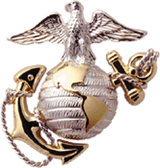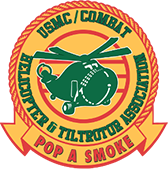
Brothers (& Sisters) Killed in Action in USMC Helicopters or while assigned to USMC Helicopter or Tiltrotor Squadrons
19710324VMO-2 (FW) Vietnam
Download PDFIncident Date 19710324 VMO-2 (FW) OV-10A 155408+ - Fuel exhaustion, parachute failed to separate from seat, drowned
Yale, Ronald Frederick 1stLT Pilot VMO-2 MAG-11 (DaNang) 1971-03-24 (vvm 04W:074)
VMO-2 Squadron Command Chronology
The squadron commenced ferrying aircraft to [NAS] Cubi Point for shipping in conjunction with its scheduled redeployment. Ten aircraft departed Da Nang on 24 March with Hostage SIX (LtCol Janz) leading. The day was marred by the loss of a squadron pilot, Lt R.F. Yale (Hostage3 FANG) who, after experiencing aircraft difficulties, ejected, however was drowned before the on-scene rescue helicopter and a boat from a nearby ship could complete the rescue.
Submitted by: N/A, 20030801Personal Narrative
Summary:
Ron was lost during retrograde of OV-10A aircraft over the South China Sea, not over North Vietnam. We were enroute to NAS Cubi Point in the Philippines. Fuel leaked from the drop tank during transfer. He shut down one engine on the presumption that he could extend the range of the airplane by doing so. It was later determined that he did not have enough fuel to get to Cubi or any other land fall, so he ejected near a Navy ship in the area and drown before the ship launch could get to him.
Details:
During that period there were malfunctions with the OV-10 ejection seat in which it failed to separate completely from the pilot. My recollection is that it didn't separate completely and held him just under the water with sufficient force that, even with his flotation gear, he could not keep his face above the water. I am not sufficiently familiar with the facets of the problem to tell you why he could not release himself from the parachute lanyard, but I think that had something to do with it, too.
There were contributing factors in addition to the ejection seat. I didn't know prior to this event that if one tries to transfer fuel from the drop tank when the main tank is full, about 5/8 of the fuel vents overboard. Occasionally, that same valve will move to the vent position even when the main tank is not full, which is what happened to Ron. After we realized that he was losing fuel, he continued to transfer to get from the drop tank all that would transfer, and then he tried to jettison the tank to reduce drag and weight. It wouldn't come off. He then decided to shut down one engine in order to increase his range. We were past Dolphin intersection, the halfway point and the briefing folder we were given that morning instructed us that if we lost an engine at that point it would take, as I recall, 800 lbs. to reach Cubi Point. He had 1100 lbs. I think there may be an advantage if one can reduce drag and fly the drift-down profile and one engine out speed (at optimum CG) and do so with precision. I don't know about the CG (although I think it was toward the aft limit) but the other factors were not in his favor. We knew little about drift-down and single engine cruise performance and range.
I would not have selected the engine shutdown option as I had previously reviewed it and decided that the advantages were so minimal as to render it more of a risk than an advantage. I had also operated on one engine on test flights and it frightened me because performance was so degraded. He had the numbers in his folder, however, and, in retrospect, I didn't question him or share my feelings about that option sufficiently to dissuade him. I have always felt some guilt about that.
The other part of the action plan was to rendezvous with the escort C-130 that was orbiting at Dolphin (about six flights of OV-10's were flying this route that day) and have him take us directly to Cubi in place of following the published route, which we were following by dead reckoning. We had accomplished that when Ron announced his decision to shut down an engine. The C-130 wanted to keep track of only one OV-10 instead of two, so I was instructed to continue at altitude via the filed route. I had been the lead. We had about 300 miles to go.
At first his prospects looked favorable for making it to Cubi, but as time went on, they decided that he simply did not have enough fuel and found a Navy ship near which to eject. An Air Force Sea-Air Rescue C-130 was launched to the scene with divers and flotation equipment. After he landed in the water, the rescue C-130 passed overhead and Ron was waving one arm at them, a signal that all is O.K. They decided not to drop the divers, as the ship was so close. The ship had some difficulty getting the launch into the water, which extended the time it took to get to Ron. When they did get to him, he was unconscious and died shortly thereafter... of drowning.
In most accidents there are multiple contributing factors. I think this event is a demonstration of that. The accident investigation board decided that the "major contributing factor" was the decision to shutdown an engine.
We were 25-year-old 800 hour 1st Lieutenants that 24th day of March 1971. We had known one another since Pensacola. We checked into New River on the same day and transitioned to the OV in VMO-1 at the same time. I went from there directly to VMO-2 in Da Nang; he went to VMO-6 in Futenma for six months before joining VMO-2. I was the Embarkation Officer and we had worked together a lot in preparation for the movement back to Camp Pendleton. He was to ride on the ship that would take the squadron equipment to San Diego. The war was over for us. All we had to do was ferry airplanes to Cubi Point for shipment to San Diego and Camp Pendleton. I believe we had requested to be scheduled in the same section; he was the scheduled leader, but didn't want to lead that day. Ron had a lot more cross-country time than I. We were very confident; we had survived; and we were eager to get on with the rest of our lives. It was a sad day - one that I will never forget but hate to remember.
Personal Narrative
Lt. Yale and Lt. Hallin were favorites among the enlisted men and so it was very hard to accept his death. Myself and another Cpl. were scheduled to fly to Cubi Pt. with these two. Myself with Lt. Yale and John Snidenbach with Lt. Hallin. However, that morning in the ready room, the assignments were changed.
I was to fly with the C.O. and Snidenbach with the X.O. I heard some of the communication over the radio and knew that Lt. Yale was in trouble. We had left Danang ahead of Lts Yale and Hallin and arrived in Cubi thinking that they would be arriving soon. When the news arrived, we were devastated.
Yale and Hallin were very good friends. I had a great deal of respect for both of them. Ron Yale was so young, we were all so young ... I've never forgotten that day.
First Hand information
Ron was one of the pilots who, along with most of the pilots in the squadron (including me), flew the OV-10 from Danang to NAS Cubi Point, Philippines when VMO-2 was withdrawn. After running short on fuel about 100 miles west of Cubi Point, he spotted a commercial ship and ejected close to it, hoping to be picked up. His seat failed to separate from his parachute and he drowned. I identified his body in Cubi Point.
Personal Commentary
Ron Yale and John Lassiter (Cobra pilot) were my best friends in the Marine Corps and both were lost over seas. They were the guys I drank with at the O Club when we received our Viet Nam orders. Ron had several dates with my sister-in-law and I kidded him about maybe being related by marriage someday. John, who finished Cobra traing in Savannah, GA just before I did, and Peggy Lassiter actually stayed an extra week in Savannah so we and our wives could hang out longer.
Shortly before Ron died, he and I swiped a jeep and drove to a USO Show. That night he expressed his concern about flying his aircraft so far over water once they deployed from Marble Mountain because of his fear of having to eject and the seat pan not seperating. I have never forgotten Ron and John and pray for their souls and peace EVERY day of my life. The BEST of America in every way.
Ron and I were friends in high school and I rented a house next to his mother and father after college. His parents kept him in touch with me though back yard visits. I was going to law school and taking private pilot lessons and Ron was coming home to go to law school we referred to each other as Sky King and Perry Mason for those old enough to remember those tv series. Ill never forget those marines coming up the drive to inform his parents. Before that they had come to my door and said Ron was coming home they were so happy what a terrible thing to go through.
Submitted by: timothy j truby, 20201125
